Organ Allocation: Proceedings of the 30th Conference on Transplantation and Clinical Immunology, 2-4 June, 1998 (Softcover Reprint of the Original 1stPaperback - Softcover Reprint of the Original 1st 1998, 9 November 2012

Qty
1
Turbo
Ships in 2 - 3 days
In Stock
Free Delivery
Cash on Delivery
15 Days
Free Returns
Secure Checkout
Part of Series
Transplantation and Clinical Immunology
Print Length
311 pages
Language
English
Publisher
Springer
Date Published
9 Nov 2012
ISBN-10
9401060916
ISBN-13
9789401060912
Description
Product Details
Book Edition:
Softcover Reprint of the Original 1st 1998
Book Format:
Paperback
Country of Origin:
NL
Date Published:
9 November 2012
Dimensions:
23.39 x
15.6 x
1.75 cm
ISBN-10:
9401060916
ISBN-13:
9789401060912
Language:
English
Location:
Dordrecht
Pages:
311
Publisher:
Weight:
458.13 gm

